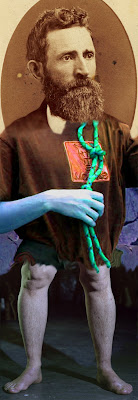gif animation is a popular form of web animation that utilizes a series of still images packaged within a single file (with a .gif extension). Gif animations on the web are often quite small so that they may play with ease when a web page is opened.
About the image:
The Right Brain vs Left Brain test ... do you see the dancer turning clockwise or anti-clockwise?
If clockwise, then you use more of the right side of the brain and vice versa.
Most of us would see the dancer turning anti-clockwise though you can try to focus and change the direction; see if you can do it.
Another gif animation:
*********************************************************************************
About Exquisite Corpse
Among Surrealist techniques exploiting the mystique of accident was a kind of collective collage of words or images called the cadavre exquis (exquisite corpse). Based on an old parlor game, it was played by several people, each of whom would write a phrase on a sheet of paper, fold the paper to conceal part of it, and pass it on to the next player for his contribution.
The technique got its name from results obtained in initial playing, "Le cadavre / exquis / boira / le vin / nouveau" (The exquisite corpse will drink the young wine). Other examples are: "The dormitory of friable little girls puts the odious box right" and "The Senegal oyster will eat the tricolor bread." These poetic fragments were felt to reveal what Nicolas Calas characterized as the "unconscious reality in the personality of the group" resulting from a process of what Ernst called "mental contagion."
At the same time, they represented the transposition of Lautréamont's classic verbal collage to a collective level, in effect fulfilling his injunction-- frequently cited in Surrealist texts--that "poetry must be made by all and not by one." It was natural that such oracular truths should be similarly sought through images, and the game was immediately adapted to drawing, producing a series of hybrids the first reproductions of which are to be found in No. 9-10 of La Révolution surrealiste (October, 1927) without identification of their creators. The game was adapted to the possibilities of drawing, and even collage, by assigning a section of a body to each player, though the Surrealist principle of metaphoric displacement led to images that only vaguely resembled the human form.
Source: "Dada & Surrealist Art," by William S. Rubin
